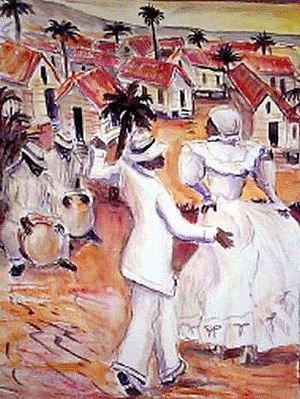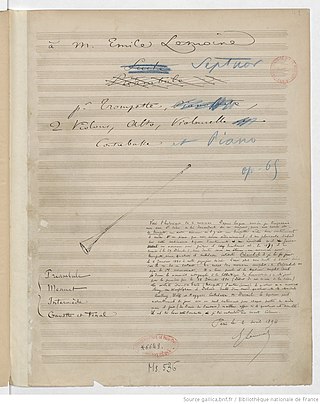Related Research Articles
In music, an ostinato is a motif or phrase that persistently repeats in the same musical voice, frequently in the same pitch. Well-known ostinato-based pieces include classical compositions such as Ravel's Boléro and the Carol of the Bells, and popular songs such as Donna Summer and Giorgio Moroder's "I Feel Love" (1977), Henry Mancini's theme from Peter Gunn (1959), The Who's "Baba O'Riley" (1971), and The Verve's "Bitter Sweet Symphony" (1997).

Louis Moreau Gottschalk was an American composer, pianist, and virtuoso performer of his own romantic piano works. He spent most of his working career outside the United States.

Bomba is an umbrella term that refers to a variety of musical styles and associated dances originating in Puerto Rico. It was developed by enslaved Africans and their descendants in sugar plantations along coastal towns, most notably Loiza, Mayagüez, Ponce, and San Juan, during the 17th century. It is the island's oldest musical tradition.

Claude Antoine Jean Georges Napoléon Coste was a French classical guitarist and composer.
Afro-Cuban jazz is the earliest form of Latin jazz. It mixes Afro-Cuban clave-based rhythms with jazz harmonies and techniques of improvisation. Afro-Cuban music has deep roots in African ritual and rhythm. The genre emerged in the early 1940s with the Cuban musicians Mario Bauzá and Frank Grillo "Machito" in the band Machito and his Afro-Cubans in New York City. In 1947, the collaborations of bebop trumpeter Dizzy Gillespie and percussionist Chano Pozo brought Afro-Cuban rhythms and instruments, such as the tumbadora and the bongo, into the East Coast jazz scene. Early combinations of jazz with Cuban music, such as "Manteca" and "Mangó Mangüé", were commonly referred to as "Cubop" for Cuban bebop.
Contradanza is the Spanish and Spanish-American version of the contradanse, which was an internationally popular style of music and dance in the 18th century, derived from the English country dance and adopted at the court of France. Contradanza was brought to America and there took on folkloric forms that still exist in Bolivia, Mexico, Venezuela, Colombia, Peru, Panama and Ecuador.
The Introduction and Rondo Capriccioso in A minor, Op. 28, is a composition for violin and orchestra written in 1863 by Camille Saint-Saëns. It was dedicated to the virtuoso violinist Pablo de Sarasate, who performed the solo violin part at the premiere in April 1867.
The "Carnival of Venice" is based on a Neapolitan folk tune called "O Mamma, Mamma Cara" and popularized by violinist and composer Niccolò Paganini, who wrote twenty variations on the original tune. He titled it "Il Carnevale Di Venezia," Op. 10. In 1829, he wrote to a friend, "The variations I've composed on the graceful Neapolitan ditty, 'O Mamma, Mamma Cara,' outshine everything. I can't describe it."

The term Creole music is used to refer to two distinct musical traditions: art songs adapted from 19th-century vernacular music; or the vernacular traditions of Louisiana Creole people which have persisted as 20th- and 21st-century la la and zydeco in addition to influencing Cajun music.

Camille-Marie Stamaty was a French pianist, piano teacher and composer predominantly of piano music and studies (études). Today largely forgotten, he was one of the preeminent piano teachers in 19th-century Paris. His most famous pupils were Louis Moreau Gottschalk and Camille Saint-Saëns.
Great Galloping Gottschalk is a contemporary ballet with choreography by Lynne Taylor-Corbett, set to the music of American composer Louis Moreau Gottschalk. It premiered with the American Ballet Theatre (ABT) at the Miami Beach Theater of the Performing Arts on 12 January 1982.

The Banjo, Op. 15, is a composition for piano by the American composer Louis Moreau Gottschalk. Composed in 1853, it is one of Gottschalk's best-known works. The piece features captivating imitations of mid-nineteenth-century African-American banjo techniques and includes demonstrations of techniques, such as up-picking and strumming, which are not found in other sources from the period.
Tresillo is a rhythmic pattern used in Latin American music. It is a more basic form of the rhythmic figure known as the habanera.
Bamboula, Op. 2, is a fantasy composition for piano written by American composer Louis Moreau Gottschalk during a delirium of typhoid fever in the French town of Clermont-sur-l'Oise in the summer of 1848. Dedicated "à sa Majesté Isabelle II, Reine des Espagnes", it is the first of the so-called set of four "Louisiana Creole pieces" that Gottschalk composed between 1848 and 1851.
Le Mancenillier, Op. 11, is a Creole-based composition for piano written by American composer Louis Moreau Gottschalk in Switzerland in the fall of 1848. Dedicated to "Madame Mennechet de Barival", it was published in Paris with the subtitle Sérénade by his publisher 'Escudiers' in April 1851. It is the fourth and last piece dubbed by musicologist Gilbert Chase the Louisiana Trilogy, written between 1844 and 1846 when Gottschalk had not yet come of age.

Jean-Amédée Lefroid de Méreaux was a French composer, pianist, piano teacher, musicologist and music critic. He is best-known for his 60 Grandes Études, Op. 63.
In music, Op. 31 stands for Opus number 31. Compositions that are assigned this number include:

The Septet in E♭ major, Op. 65, was written by Camille Saint-Saëns between 1879 and 1880 for the unusual combination of trumpet, two violins, viola, cello, double bass and piano. Like the suites Opp. 16, 49, 90, the septet is a neoclassical work that revives 17th-century French dance forms, reflecting Saint-Saëns's interest in the largely forgotten French musical traditions of the 17th century.
References
- ↑ Nicholas, Jeremy. "Souvenir de Porto Rico 'Marche des Gibaros' RO250 Op 31". Hyperion-records.co.uk. Retrieved 7 July 2012.
- 1 2 3 Burkholder, J. Peter (2006). Norton Anthology of Western Music . ISBN 9780393979923.
- ↑ Teachout, Terry, Our Gottschalk, Commentary Magazine, 2008
- 1 2 Pruett, Laura Moore (2007). Louis Moreau Gottschalk, John Sulivan Dwight, And The Development Of Musical Culture In The United States. 1853-1865 (PDF). The Florida State University. pp. 116–123.
- ↑ "Souvenir de Porto Rico, marche des gibaros for piano, Op. 31, D. 147 (RO 250)" Classical Work Reviews. All Media Guide, 2006. Answers.com, 14 Feb. 2008